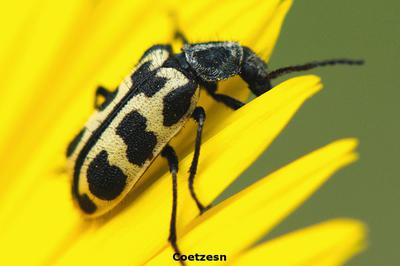Spotted Maize Beetle
Astylus atromaculatus
Insect
In a Nutshell
- Clusters of yellow, elongated beetles with black spots on flowers and maize heads.
- Damage to silks or grains.
- Damage to seeds or germinating maize seedlings and reduction of plant stand.
Can also be found in
Symptoms
Clusters of yellow, elongated beetles with black spots on flowers and maize heads. Damage to seeds or germinating maize seedlings and reduction of plant stand. This insect is actually considered an efficient pollinator as its flight range can occasionally reach up to 200 m or even more. Only when conditions are favorable may it develop into a pest (warm, dry weather and temperature above 15°C). Even in these conditions, they do not usually cause sufficient damage to justify control with insecticides.
Recommendations

Organic Control
Habitat management with known predators (cereal stemborers) together with a plant push-pull system (consisting of an intercropping with Desmodium and a barrier with Napier grass) has worked well in the past to deter this occasional pest from feeding on crops.

Chemical Control
Always consider an integrated approach with both preventive measures together with biological treatments if possible. Methods currently recommended for the control of the Astylus beetle include chemical seed treatments and chemical sprays.
What caused it?
The damage is caused by the spotted maize beetle, Astylus atromaculatus. Adult beetles are slightly elongated, and have yellow wing covers with black spots. They are mainly herbivorous and feed on silk, pollen or grains from crops such as maize, rice, sorghum or sunflower. They usually do not cause much damage to these plants. When there are too few crops in the field, the beetles gather gregariously in grasses and can be a problem if they are ingested by cattle, with a possibility of causing deaths. Females lay the eggs under dry leaves. Larvae live in the ground and feed on decaying plant debris. They can also sometimes cause damage to seeds or germinating maize seedlings, thus reducing plant stand. Periods of warm, dry weather (above 15°C) favors their life cycle.
Preventive Measures
- Avoid monocrop systems as this favors the development of the pest.
- Use yellow buckets filled with water or traps baited with 2-phenyl ethanol to reduce populations.



